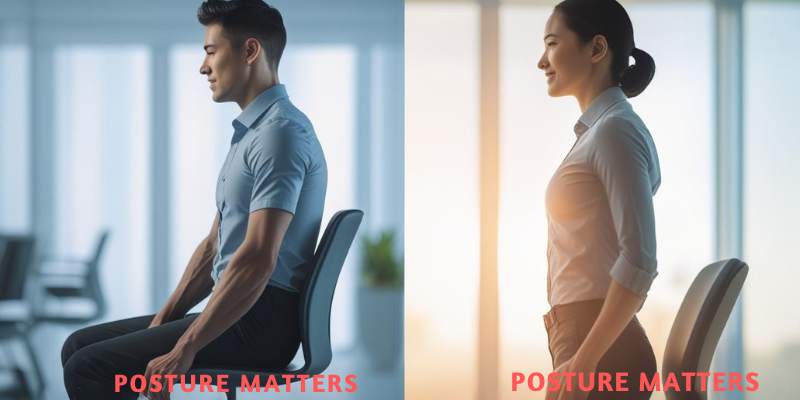7 Body Language Mistakes You’re Probably Making (And How to Fix Them for Success)
Published: 10/08/2025
“Did you know that your body language could be holding you back in your career and personal life?”
We often focus on the words we say, but what about the way we present ourselves nonverbally? Body language plays a crucial role in how we’re perceived by others, and the reality is that even the smallest body language mistakes can have a big impact.
Whether you’re in a job interview, leading a team, or trying to make a good impression at a social event, unintentional body language errors can affect how people view your confidence, professionalism, and trustworthiness. These mistakes, though subtle, could be hindering your career success and personal relationships more than you realize.
But don’t worry—this article is here to help! We’ll explore the 7 most common body language mistakes you’re probably making and provide simple, actionable fixes that will help you improve your nonverbal communication. By making these adjustments, you’ll not only boost your confidence but also enhance your career prospects and build stronger relationships both professionally and personally. Let’s dive in! |
The Impact of Body Language on Your Success
Body language is often the first thing people notice, and it can shape initial perceptions long before you even speak. In the fast-paced world of business, mastering these non-verbal cues can make all the difference in how you are perceived and how successful your interactions are.
Why Body Language Matters in Professional Settings
Your body language speaks volumes before you even say a word. In professional settings, your non-verbal cues—such as posture, gestures, and facial expressions—can significantly affect how you’re perceived by others. Whether it’s a job interview, a business meeting, or a negotiation, the way you carry yourself often communicates more than your actual words. For instance, a confident posture can convey that you’re self-assured and prepared, while slouching or avoiding eye contact can make you seem disengaged or lacking in confidence.
Real-life Example:
Sheryl Sandberg, the former COO of Facebook, as an example. She’s known for her strong body language, especially her firm handshake and steady eye contact during high-stakes business meetings. These small yet powerful cues have helped her not only secure important deals but also earn the respect of colleagues and leaders worldwide. Her body language is an essential part of how she projects authority, trustworthiness, and competence.
How Body Language Influences Personal Relationships
Just as body language plays a huge role in professional settings, it’s equally crucial in personal relationships. Whether you’re speaking with friends, family, or on a date, your body language can significantly impact the trust and rapport you build with others. A warm, open posture shows that you’re engaged and approachable, while a defensive posture, like crossing your arms, can create emotional distance and even imply that you’re not interested in the conversation.
Example:
Imagine a conversation between two people at a social gathering. One person has their arms crossed and avoids eye contact, while the other is leaning slightly forward, smiling, and maintaining steady eye contact. The person with the open, engaged body language is far more likely to seem approachable, making it easier to establish rapport and connection. On the other hand, the individual with closed-off body language may unintentionally seem distant, even though they might be genuinely interested in the conversation.
7 Common Body Language Mistakes You’re Probably Making
Before diving into the common mistakes, it’s important to remember that body language is a powerful tool in shaping how others perceive you. Small adjustments can make a big difference, whether you’re aiming to make a strong first impression or build rapport in a conversation. Let’s begin by exploring one of the most fundamental aspects of body language: posture.
Mistake 1: Poor Posture
Before diving into the details of why poor posture is harmful, it’s important to understand just how much body language affects our interactions. It’s not just about standing tall or slouching—it’s about the messages we send without saying a word. Our body language can influence first impressions, trust, and even how confident we feel in our own abilities. Poor posture can be one of the most subtle, yet impactful, mistakes that holds us back from making the best impression. Let’s explore why this seemingly small habit can make such a big difference.
Why It’s Harmful:
- Slouching or poor posture can be a major turnoff in both professional and personal settings. When you slump or hunch over, it signals lack of confidence and disinterest. This not only affects how others perceive you, but it can also influence how you feel about yourself. Poor posture can make you appear disengaged or unsure, which can negatively impact professional relationships and personal connections.
How to Fix It:
- A quick fix is as simple as standing tall with your shoulders back and spine aligned. Think about the way confident leaders and public speakers carry themselves—they maintain upright posture that projects authority and confidence. If you’re sitting, try to sit upright with your feet flat on the floor and shoulders relaxed. To make this a habit, practice power poses in front of a mirror to reinforce strong, confident body language.

Mistake 2: Avoiding Eye Contact
Before we explore why avoiding eye contact can be harmful, it’s important to understand just how crucial nonverbal communication is. Eye contact, while simple, has a profound impact on how others perceive us. It’s a key element in building rapport and trust, making it much more than just a fleeting glance. Small shifts in how you make eye contact can significantly affect how connected and engaged you appear.
Why It’s Harmful:
- Eye contact is one of the most powerful forms of nonverbal communication. When you avoid eye contact, it can make you seem evasive, untrustworthy, or even disinterested in the conversation. Whether you’re in a job interview, speaking to a client, or having a personal conversation, lack of eye contact creates emotional distance and diminishes your credibility.
How to Fix It:
- To fix this, try to maintain appropriate eye contact throughout the conversation, but don’t overdo it. Aim for 50-60% eye contact to avoid staring, which can feel intimidating. Practice by looking into someone’s eyes while they’re talking, and then occasionally glance away before returning your focus. This creates a natural rhythm and shows that you’re engaged and attentive.
Mistake 3: Crossing Arms
Before we get into why crossing arms can be harmful, it’s worth considering the subtle yet powerful messages our body language sends. Even the smallest gestures, like how we position our arms, can shape how others perceive us. While crossing your arms might feel natural or comfortable, it can unknowingly create distance in your interactions. Let’s look at why this simple mistake can have such a big impact.
Why It’s Harmful:
- Crossing your arms is often interpreted as a defensive or closed-off gesture. While you might not even realize it, this simple body language mistake can give off the impression that you’re shutting down or not open to the conversation. In both professional and social settings, this can create a barrier between you and the other person, leading to a breakdown in communication.
How to Fix It:
- Try to keep your arms relaxed by your sides or resting comfortably on your lap or the table. If you’re standing, open gestures such as holding your hands loosely in front of you or clasping them in a non-confrontational manner will help convey openness and receptiveness. If you catch yourself crossing your arms, consciously uncross them and try to use gestures to express yourself more naturally.
Mistake 4: Fidgeting or Nervous Movements
Before we dive into why fidgeting can be harmful, let’s think about how nervous movements might affect how others see us. When we’re nervous or unsure, our body often gives it away, whether it’s through tapping our foot or shifting constantly in our seat. These small actions can create a sense of discomfort for both us and the people we’re communicating with. Let’s take a closer look at why fidgeting can hurt your presence and credibility.
Why It’s Harmful:
- Nervous habits like tapping your foot, clicking a pen, or constantly shifting in your seat can make you appear anxious and lacking in control. These movements distract from your message and can undermine your credibility in professional settings or make you seem uneasy in social situations. Constant fidgeting might also signal to others that you’re not confident or not fully engaged.
How to Fix It:
- To reduce nervous fidgeting, practice staying still while speaking. One helpful technique is to focus on deep breathing, which can calm your nerves and reduce the urge to fidget. Additionally, try to keep your hands relaxed and use them purposefully when talking. If you’re sitting, try to keep your feet flat on the floor and focus on maintaining steady posture.

Mistake 5: Weak or Overpowering Handshakes
Before we get into the specifics of why handshakes matter, consider how much they influence the impression you make. A handshake might seem like a small gesture, but it’s one of the first things we judge when meeting someone new. Whether you’re in a professional interview or a casual meeting, a handshake can speak volumes about your confidence and approachability. Let’s take a closer look at how the strength of your handshake can shape the way others perceive you.
Why It’s Harmful:
- A weak handshake can make you appear insecure and lacking in confidence, while an overly firm handshake can come off as too aggressive or even intimidating. Both extremes leave a poor first impression and may affect how you’re perceived, especially in professional environments like job interviews or business meetings.
How to Fix It:
- The key to a great handshake is balance. Aim for a firm but gentle handshake that communicates confidence without being overpowering. Grip the hand firmly (but not too tightly), make eye contact, and offer a warm smile. Practice with a friend or colleague to find the right balance that feels comfortable and professional.
Mistake 6: Not Smiling or Having a Stern Expression
Before exploring the consequences of a stern or neutral expression, let’s consider how often we judge others based on their facial cues. A warm expression can instantly make you seem more approachable and inviting, setting the tone for positive engagement. Now, let’s take a closer look at how not smiling can affect your interactions.
Why It’s Harmful:
- A neutral or stern expression can make you appear unfriendly, unapproachable, or even upset, even if that’s not your intention. In personal and professional interactions, your facial expression plays a key role in how others perceive you. If you’re consistently serious or frowning, it can make others feel uneasy and less likely to engage.
How to Fix It:
- To fix this, consciously smile more often, especially in social situations or when greeting others. A genuine smile not only makes you appear approachable but also conveys warmth and positivity. If you’re in a professional setting, try to maintain a neutral yet relaxed expression when you’re not actively speaking to avoid looking overly stern.

Mistake 7: Invading Personal Space
Before we explore why invading personal space can be harmful, consider how we instinctively respond to physical proximity. Personal space is something we often take for granted, but when it’s violated, it can create a sense of discomfort or even anxiety. Respecting these boundaries is key to maintaining positive and productive interactions. Let’s take a closer look at why this small mistake can have a big impact.
Why It’s Harmful:
- Personal space violations can make others feel uncomfortable, invaded, or even threatened. Everyone has a personal space bubble, and respecting that bubble is essential for maintaining positive relationships. Invading someone’s personal space, especially without their permission, can negatively affect your credibility and trust in both personal and professional interactions.
How to Fix It:
- Pay attention to the distance between you and others in a conversation. In professional settings, the typical social distance is around 1.5-2 feet. Be mindful of body language cues from others, such as backing away or stepping back, and adjust your positioning accordingly. Always ask yourself: “Am I making the other person feel comfortable?” If in doubt, give them a little more space.
How to Improve Your Body Language for Success
Improving your body language for success isn’t just about avoiding mistakes—it’s also about actively adopting positive habits. One of the easiest ways to start making an impact is by incorporating gestures that reflect confidence and openness. Let’s take a closer look at how simple adjustments, like using open gestures, can instantly transform how others perceive you and help you communicate more effectively.
Focus on Open, Confident Gestures
Body language is often more about how you say something than what you say. One of the most powerful ways to improve your body language is by using open, confident gestures. These types of gestures not only make you appear more approachable and trustworthy but also enhance your ability to communicate effectively. When you adopt an open posture, you signal to others that you are receptive, engaged, and confident in what you’re saying.
Dr. Amy Cuddy, a leading social psychologist, emphasizes this by stating:
Your body language shapes who you are. By making small changes to our posture and expressions, we can change the way others perceive us—and even how we perceive ourselves.Dr. Amy Cuddy (Social Psychologist and Author of *Presence: Bringing Your Boldest Self to Your Biggest Challenges)
Why It Matters:
When your body is open and welcoming, others are more likely to feel at ease around you. On the contrary, closed body language (like crossing your arms or turning your body away) sends the message that you are defensive or not fully engaged. In professional settings, this can hurt your ability to build rapport and establish trust, especially in situations like interviews, presentations, or meetings.
How to Fix It:
Here are a few quick tips to implement open, confident gestures:
- Use your hands while speaking: When explaining or making a point, hand gestures can emphasize your message and make you seem more engaged. However, be careful not to overdo it; the key is to use gestures naturally.
- Position your body towards the person: Whether you’re sitting or standing, angle your body toward the person you’re talking to. This shows that you’re actively listening and open to communication.
- Relax your shoulders: Tension in your shoulders can make you appear defensive. Keeping your shoulders loose and relaxed will make you look more comfortable and confident.
Practice Consistency Between Words and Body Language
One of the most powerful elements of effective communication is consistency. If your body language and words send conflicting messages, it can create confusion and mistrust. For example, if you say you’re excited about an opportunity but your body language is slouched and closed off, people may start to question your sincerity or authenticity. This discrepancy between verbal and non-verbal communication can undermine your credibility and weaken your overall impact.
Why It Matters:
Your words and body language must be in harmony to convey authenticity and clarity. When they are inconsistent, people may feel uncertain about your true feelings or intentions. This can lead to misunderstandings, especially in situations where trust and engagement are critical, such as job interviews, sales presentations, or negotiations.
How to Fix It:
Here’s how you can ensure consistency between your verbal and non-verbal communication:
- Be aware of your body language: Pay attention to how your body responds when you speak. If you’re saying something positive, make sure your body language reflects that positivity. Stand tall, smile, and maintain open gestures.
- Align your facial expressions: Your face is one of the most powerful tools for communicating. Ensure your facial expression matches your words. If you’re speaking about an exciting project, a smile or enthusiastic expression will help reinforce that message.
- Use congruent body movements: For example, if you’re speaking passionately about a topic, lean slightly forward and use gestures to emphasize your points. This shows that your body language is aligned with the energy of your words.
By practicing consistency between your words and body language, you’ll be able to communicate more clearly and build stronger relationships based on trust and authenticity.
Mastering Non-Verbal Cues for Leadership
Effective leadership isn’t just about what you say, but how you carry yourself. Non-verbal cues are an essential tool for projecting authority, building trust, and inspiring respect in professional environments. As a leader—whether you’re already in a leadership role or aspiring to become one—body language can elevate your presence, shape how others perceive your confidence, and ultimately influence the success of your leadership.
Why It Matters:
Your body language can either reinforce or undermine your words. Leaders who are aware of their non-verbal communication are better equipped to command attention, inspire their teams, and foster a culture of respect. Missteps, like slouching or failing to make eye contact, can signal to your team that you’re either uninterested or lack authority, even if your words say otherwise.
How to Fix It:
Here are some targeted strategies for executives and aspiring leaders to master non-verbal communication in the workplace:
Stand Tall with Good Posture:
- When you enter a room, stand tall with your shoulders back and head held high. This instantly projects confidence and authority. A strong posture also signals that you’re mentally present and engaged, which can help others respect and follow your lead. Think of leaders like Oprah Winfrey or Barack Obama, who are known for their upright and commanding presence in public speaking settings.
Use Purposeful Gestures:
- When speaking in meetings or presentations, don’t be afraid to use hand gestures to emphasize key points. Open gestures—with palms facing up or outward—show that you are receptive and inclusive. Avoid crossing your arms, as this can make you seem closed off or defensive. Gestures should feel natural and connected to what you’re saying, reinforcing your message.
Maintain Steady Eye Contact:
- Eye contact is one of the most powerful forms of non-verbal communication. It conveys confidence, trustworthiness, and interest. As a leader, maintaining eye contact with your team members shows that you’re paying attention and that you value their input. Avoid darting eyes or looking at your phone during conversations—it’s a sign of disengagement. Practice shifting your gaze around the room to include everyone when speaking to a group.
Facial Expressions Matter:
- Leaders are often evaluated based on their expressions, whether they realize it or not. A neutral or stern expression can create emotional distance, while a genuine smile or warm expression helps humanize you and makes others feel comfortable. When addressing your team, make sure your expressions match the tone of the conversation. A supportive smile can make an announcement feel more positive, while a serious expression signals when something needs to be addressed with urgency.
Physical Presence in Meetings:
- When you’re in a meeting, position yourself in a way that encourages open communication. Sit upright, and make sure you’re facing the speaker or the group. If you’re standing, keep your feet shoulder-width apart for a stable, grounded stance. Be mindful of how your body is positioned; if you’re leaning back or turning away from others, it could imply that you’re disengaged or uninterested in what’s being said.
By mastering non-verbal cues, leaders can command attention, express authority, and create an environment that fosters respect and trust. These small but powerful adjustments to posture, gestures, and facial expressions will not only help you lead more effectively but will also boost your confidence and presence as a respected leader.
Expert Tips for Improving Your Body Language
Improving your body language is a journey, and sometimes, the best way to enhance it is by learning from those who do it well. Successful leaders, for example, naturally use body language to build influence and trust. By mirroring their actions, you can quickly align yourself with their confidence and effectiveness. Let’s dive into how this simple technique can elevate your presence.
Mirror the Body Language of Successful Leaders
One of the most powerful techniques for improving your own body language is to mirror the body language of successful leaders. Mirroring is a subconscious technique where you subtly imitate the posture, gestures, and movements of the person you’re interacting with. This helps build rapport and trust, signaling that you are aligned with them and that you’re genuinely engaged in the conversation.
Why It Works:
Mirroring creates a sense of connection and mutual understanding. When we subconsciously mimic someone else’s body language, it encourages them to feel more comfortable and valued. This is especially important when you’re trying to foster strong professional relationships, whether with a colleague, client, or potential business partner. It helps strengthen bonds and ensures smooth communication.
How to Mirror Body Language Effectively:
- Match posture: If your conversation partner leans forward, try leaning forward slightly as well. If they sit upright, do the same.
- Gesture synchronization: If they use hand gestures while speaking, subtly incorporate similar gestures. However, avoid being overly obvious with the mirroring—subtlety is key.
- Facial expression: If they smile, smile back. If they appear serious, adjust your facial expression to show attentiveness.
Example of a Successful Leader’s Body Language:
Consider Barack Obama, who was known for his calm, confident demeanor. His ability to maintain eye contact, stand with a strong posture, and use purposeful hand gestures made him an effective speaker. You can adopt his practices of open hand gestures, steady eye contact, and relaxed posture when speaking in public or during meetings to exude confidence and credibility.
Simple Exercises to Build Confidence in Your Body Language
Improving your body language doesn’t always require changing how you move; sometimes it’s about building confidence in how you carry yourself. A few simple body language exercises can have a significant impact on your overall presence and self-assurance.
Power Poses:
Research by social psychologist Amy Cuddy suggests that standing in a power pose for just a couple of minutes can help boost your confidence. Try standing with your feet shoulder-width apart, your hands on your hips, and your chest open. Holding a power pose before a meeting or job interview can increase your feelings of confidence and make you appear more authoritative to others.
Confident Standing:
A common issue many people face is slouching. To fix this, practice standing with your back straight, shoulders back, and your head held high. Imagine you have a string pulling you upwards from the top of your head. This exercise helps improve posture and conveys confidence, even if you’re nervous.
Mirroring Yourself in the Mirror:
Sometimes the best way to adjust your body language is by practicing in front of a mirror. Spend a few minutes each day observing your body posture and facial expressions as you practice smiling or speaking confidently. Adjusting your posture in real-time can help you become more aware of any negative body language habits you might have.
Breathing Exercises:
Deep, controlled breathing can help calm nerves and maintain steady body language. Practice slow, deep breaths to regulate your heart rate and release tension, especially before important conversations or presentations.
By incorporating these exercises into your daily routine, you’ll feel more confident and have stronger body language that reflects your inner confidence.
Common Body Language Mistakes to Avoid in Professional Settings
In professional settings such as job interviews, meetings with VIPs, or client negotiations, your body language can heavily influence your success. Here are some common mistakes people make in these contexts and how to fix them:
Job Interviews
Before we dive into why avoiding eye contact can be a problem in job interviews, let’s think about how much a simple glance can communicate. Eye contact is one of the first ways we connect with someone, and in an interview, it’s crucial for building rapport. By adjusting this small detail, you can immediately improve your chances of making a strong impression. Now, let’s see why eye contact matters so much in job interviews.
- Mistake: Avoiding Eye Contact
In interviews, failing to maintain eye contact can make you appear unprepared or evasive. It can also give the impression that you lack confidence. - Fix: Maintain steady eye contact with your interviewer throughout the conversation. Look at them when they speak and when you’re responding, but remember to break eye contact occasionally to avoid staring. This shows you’re engaged but not aggressive.
Meetings with VIPs
When meeting with VIPs, your body language speaks volumes, often more than your words. A professional and confident presence can set the tone for the entire conversation, so make sure your posture reflects your engagement and authority.
- Mistake: Slouching or Sitting Too Far Back
Sitting with a slouch or too far back can suggest disinterest or lack of authority, especially in important meetings. - Fix: Sit upright with your feet on the floor and your body slightly leaned forward. This shows that you are engaged and have confidence in the discussion.
Client Negotiations
In client negotiations, your body language can significantly influence the outcome of the conversation. A confident and open posture fosters trust and cooperation, making the negotiation process smoother and more productive.
- Mistake: Using Closed-Off Gestures
Crossing arms, looking away, or failing to lean in can create a barrier between you and the client, signaling resistance or discomfort. - Fix: Open your posture and lean slightly forward to show you are interested and engaged. This builds rapport and encourages cooperation during the negotiation.
Body language is often more important than the words you say, especially in high-stakes situations like job interviews or client meetings.
Peter Drucker, a renowned management consultant, once said:
The most important thing in communication is hearing what isn’t saidPeter Drucker, Renowned Management Consultant and Author
By being mindful of these body language mistakes, you can project confidence, credibility, and approachability in any professional situation, ultimately helping you build stronger relationships and increase your chances of success.
Conclusion
We’ve covered some of the most common body language mistakes that can affect your career success, personal relationships, and self-confidence. Here’s a quick recap of the 7 mistakes and the simple fixes that will help you make a lasting, positive impression:
- Poor Posture – Stand tall and align your spine to project confidence.
- Avoiding Eye Contact – Maintain steady eye contact to show engagement and trustworthiness.
- Crossing Arms – Keep your arms open and relaxed to signal receptivity and openness.
- Fidgeting or Nervous Movements – Stay calm and focused by practicing deep breathing and controlled movements.
- Weak or Overpowering Handshakes – Use a firm but friendly handshake to communicate confidence without aggression.
- Not Smiling or Having a Stern Expression – Smile and relax your facial expressions to appear more approachable and warm.
- Invading Personal Space – Maintain a respectful distance to avoid making others uncomfortable.
By making these simple adjustments, you can instantly improve how you’re perceived and foster better relationships, both personally and professionally.
Now that you know the body language mistakes to avoid and the fixes to implement, it’s time to start practicing these tips right away. Spend a few minutes each day working on your posture, gestures, and facial expressions. Try applying these adjustments in your next conversation or meeting, and notice the positive changes in how others respond to you. The more you practice, the more natural it will feel, and soon you’ll be projecting the confidence and approachability you desire.
Your Top Questions Answered: Body Language & Beyond
In interviews, your body language provides non-verbal cues that help interviewers assess your confidence, engagement, and professionalism. “Posture”, “eye contact”, and “gestures” convey your interest in the job, while “fidgeting” or “closed-off body language” can signal nervousness or disinterest. “Positive body language” can make a lasting impression and increase your chances of landing the role.
To project confidence, work on improving your “posture” by standing tall, making “eye contact”, and using “open gestures”. Practice “power poses”” before important meetings or interviews to boost self-assurance. A relaxed, yet assertive body language communicates that you are in control and confident.
Avoid mistakes like “slouching”, “avoiding eye contact”, “crossing your arms”, or “fidgeting”. These can make you appear uninterested, anxious, or defensive. Instead, focus on “open gestures”, “positive facial expressions”, and maintaining “appropriate eye contact” to show confidence and engagement.
Your body language can shape how others perceive you in the workplace. Positive body language can enhance “leadership”, build “trust”, and help with “rapport-building” in professional settings. Poor body language can hinder your career by making you appear disengaged, insecure, or unapproachable.
In social situations, focus on “maintaining open posture”, “making eye contact”, and using “warm facial expressions”. Smiling and “actively listening” are key components of building rapport and making people feel comfortable. Avoid crossing your arms, as this can appear closed off.

- Be Respectful
- Stay Relevant
- Stay Positive
- True Feedback
- Encourage Discussion
- Avoid Spamming
- No Fake News
- Don't Copy-Paste
- No Personal Attacks



- Be Respectful
- Stay Relevant
- Stay Positive
- True Feedback
- Encourage Discussion
- Avoid Spamming
- No Fake News
- Don't Copy-Paste
- No Personal Attacks




